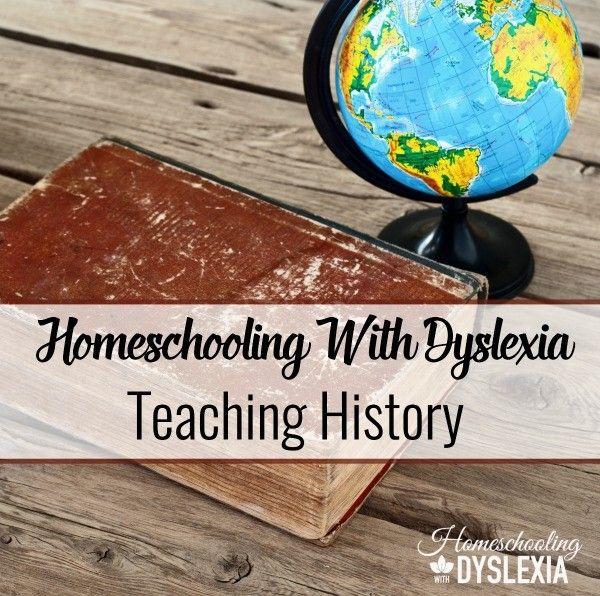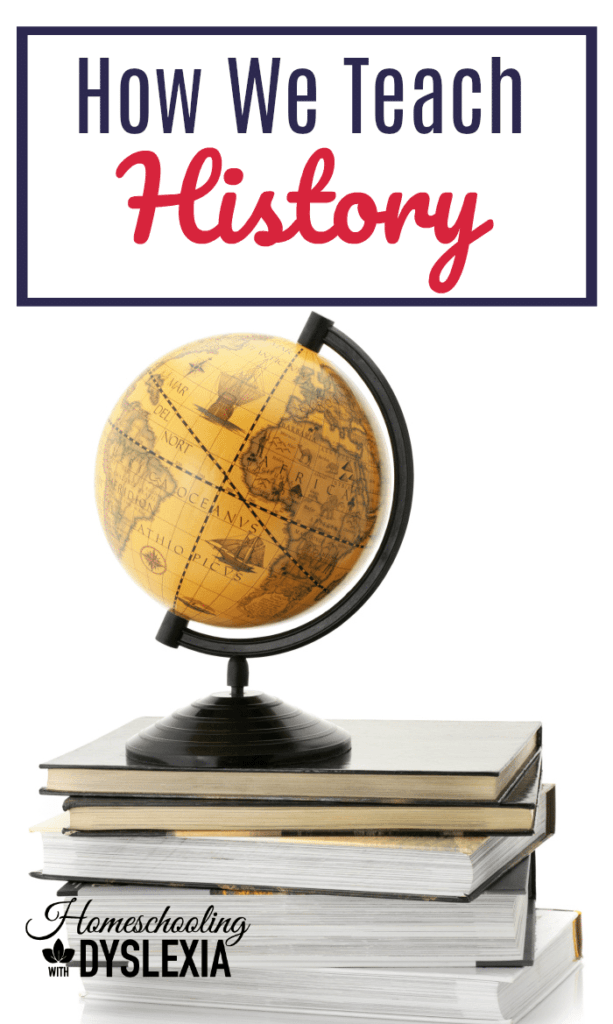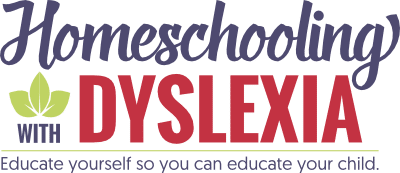Are you wondering how to teach history? I am sharing how we teach our dyslexic kid’s history. Learn tips and methods that can help you teach history in your homeschool.

Thanks for joining me for day 4 of the 5-day series on Homeschooling With Dyslexia by the Subject. So far we’ve covered How Dyslexics Learn in General, Language Arts, Math, and Science. Today’s subject is History.
In my post on how dyslexics learn, I pointed out that in most cases, dyslexic learners, who are very bright, just learn differently. This is, by the way, why you will often hear me calling dyslexia a learning difference rather than a learning disability. It is important for parents, especially homeschooling parents, to understand the strengths and not just the weaknesses of their kids. In general, you want to teach to the strengths of your student.
In my experience, my kids generally learn better by hearing. If they are asked to read for history, they understand and remember less than if they hear their history lessons. If I ask them to write down their thoughts, they will struggle to organize their thoughts and then once they are organized they will lack the ability to spell half the words. (This is not to say that we never assign reading and writing, just not during history!) Using a traditional textbook approach, where the child reads their lesson for the day and then answers the questions at the end of the chapter, is going to cause some friction in a homeschool with dyslexic learners. Ask me how I know!
The way we study history has changed dramatically for the good since we began homeschooling some 18 years ago.
History Curricula That Work With Dyslexia
There are many excellent history resources out there. Since there is a good chance that for at least most of the elementary grades you will be reading the text aloud, you may as well make it interesting, no? We do have a history textbook or two around still for reference, but for the most part, we are using living books to study the lives and events of each period of history.
This is a secular history program that is chronologically based; History of the World starts with the beginning of time and runs through til modern times. History of the World has the main text that is story based and a collection of student activity pages that include map making, crafts, coloring pages, recipes and many other hands-on resources and ideas.
Listening and Narrating
What we like about the program is that we can purchase the main text on CD to listen to as a family. The student guide includes narration questions which I ask after each chapter. The kids take turns answering, which often ends up in discussions of what we are learning.
Using this method, it is not unusual to find a 2nd or 3rd grader who can narrate a good portion of history if asked. These are the same kids who, if asked to write this information, would fail miserably.
We follow this up, time permitting, with an activity from the student book. Many of these pages can be stored in a notebook that makes an excellent source for reviewing and remembering what was learned.
Using this method, history has become my kids’ favorite subject.
Other curricula that we have used with success are:
This is a complete, literature-based curriculum that branches off, in large part, the time of history being studied. Useful for multiple ages, it is an excellent curriculum for teaching multiple ages at once.
Another literature based history program full of wonderful living books and ideas for a simple notebook included in the Study Guide.
In a homeschool with dyslexic students, one of the main problems with teaching history (or any ‘elective’) is finding the time. Since the study of language arts takes so long, it is hard to find the time to teach the ‘extras’. When our kids reach middle school age, around 7th grade really, we bought this computerized history program from Switched on Schoolhouse (SOS). Although this uses the traditional textbook approach, it does have a text-to-speech function that allows the text to be read aloud to the student. I found this program to be an excellent transition from our more relaxed methods of teaching in the elementary years to the more structured study methods of the high school year.






I wanted to ask if anyone has joined Classical Conversations with their dyslexic child? I’m trying to figure out if this approach will work with my kids style of learning.
Waverly – we are beginning our second year of Foundations and Essentials. We love it. It is a great fit for multi sensory learning. Here is a post that I wrote about CC on my general homeschool blog: http://www.mariannesunderland.com/2014/10/17/can-kids-dyslexia-classical-conversations/
Read through the comments for some good feedback. I do think that you need to keep realistic expectations for dyslexic kids – i.e.. they may not be the quickest kid to respond if they have auditory processing issues etc. Our CC group is very good about keeping competition to a minimum so our kids really enjoyed and learned a lot! We do CC once a week, review every day, do reading and math and try to read aloud at least 3 days a week. It makes teaching a lot easier for me – especially since we’re all learning the same things. Hope this helps!
I should say that Essentials (the writing and grammar part) was pretty intense the first year. I have heard that that is the case for most kids. It is during the second year that things start to click more. My kids learned a TON and there is a LOT of flexibility in the program which we took advantage of. 🙂
Great stuff here. Just one correction, it’s The Story of the World, not History of the World. I’ve used it for years with my 4 children, my last being dyslexic.
Has anyone used Mystery of History with the audio CD with a dyslexic student and found that to be a good fit? I am trying to figure out what to use with my upcoming 9th grader that he can do independently and that will stick. Thanks!
Hi, did you go with MOH? Interested. Thx
Mystery of History has worked great for my son. Used it in conjunction w related literature and videos. History is one of his favorite subjects now. He’ll be in 10th grade in the fall.
Acellus Academy works best for us. All subjects are presented via short video segments followed by a multiple choice quiz.
I have been using Mystery of History with my dyslexic teen. Due to the short lessons we are able to do the time line, mapping , quizzes and that still leaves us time to add in books for her to read.
I have a question. This is my 1st year of homeschooling, this upcoming September, for my 7th and 4th grade boys. Both are dyslexic, which is why I chose to pull them from public school, as they were barely making the grade. I am dyslexic and it runs in the family, so I am familiar with it. I am struggling to figure out the best way to teach both boys, and the most economic way as well, since money is tight. I am trying to figure out where to begin. I have had quite a bit of help from friends, but the problem is that their kids don’t have learning challenges, so I have to be more creative. I really like the Mystery of History book, as I have seen it in person, and was planning on getting the audio cd to go along with the book. I was just looking at Switched on Schoolhouse from Christian book distributors, but they had no reviews and that’s how I found your page. My problem with it, is that it is a more expensive program, that is only geared toward my 7th grader. Would you recommend that I get a whole curriculum that is only geared for him, for more independent study, because he is a 7th grader, or should I keep trying to find ways to integrate and teach both ages with different, age appropriate work? I don’t want him to feel I dumbed him down, by teaching with his brother, but I know how hard he has struggled to keep up with his 6th grade subjects this year. Math has been an especially, sore subject, because it was his favorite, until this year. I am looking into the math-u-see set, but am unsure about that as well. Any suggestions would be greatly appreciated! PS, I am trained in Montessori teaching style, so I have tried those methods a bit, but not recently with them.
Hi Alicia. I would recommend doing history with Mystery of History. It will be different but not dumbed down. You can assign more work for your 7th grader and less for your 4th grader. SOS has a purpose. For us, we used it when I needed help to teach history because of a lack of time. However, it was not an enjoyable experience. Of course, your son is used to the textbook approach to learning from school so he may not mind so much. MoH will be more enjoyable. It depends on your goals. Are you trying to restore a love of learning or ??? For math, we really like Teaching Textbooks as well. There are placement tests on their web site so you can see where to start him. You have a few years before high school to be creative and teach more for enjoyment and to find out the boys’ interests. Hope this helps!
We’ve cycled through Story of the World for years now. We needed a change this year with my older two going into 7th and 9th. It’s my 7th-grade daughter who has dyslexia and dysgraphia and I’m struggling to find a good fit. I was told about The Good and The Beautiful and it looks like it would work well. It’s a four-year cycle as well, but it sweeps through all time periods each year instead of concentrating on one time period a year. I thought that might be a good way to not burn her out. It’s family style, like SOTW, but has a varying degree of activities for each grade. There is short lessons you read aloud, part that is audio, and some hands-on activities along with maps. Anyhow,,, this is what I’m contemplating this year. Since it’s only a few years old I’m curious if anyone else has used it.
Hi Amy. I have not used The Good and the Beautiful History. I know a lot of people like it. I read this review by Cathy Duffy and it seems like, although it is a good program, it may not go into as much depth as your older kids may need – especially the 9th grader.